You may have heard the terms “upper explosive limit” and “lower explosive limit,” but what do they mean in relation to electrostatic discharge flooring?
Explosive situations can arise when dangerously high charges lead to ignition hazards caused by static charges during industrial processing. Such a hazardous event occurs when two conditions coexist: a dangerously high charge and a potentially explosive atmosphere. These conditions can arise when handling non-conductive, combustible liquids, non-conductive combustible bulk solids or hydrocarbons. Surprisingly, conductive materials processed in non-conductive equipment can also accumulate dangerously high charges.
Understanding the upper and lower explosive limits
In terms of electrical standards, the maximum resistance allowed for a grounded conductive floor in most munitions, explosives and flammable processing areas is one million ohms. This total resistance includes the resistance of the body, the resistance of conductive shoes and the resistance of the conductive floor to the ground systems, as measured on an ohmmeter.
The upper explosive limit refers to the highest concentration above which a flame will not spread in the presence of an ignition source, such as a flame, arc or heat. Concentrations higher than the upper explosive limit are considered “too rich” to burn.
On the other hand, the lower explosive limit is the lowest concentration below which a flame will not spread in the presence of an ignition source. Concentrations below this limit are not sufficiently strong to sustain combustion.
Flammable and combustible liquids and dust pose significant risks when exposed to air. When vaporized, they can form flammable mixtures with oxygen, leading to ignition within specific fuel-to-air ratios. These mixtures must fall within the Lower Explosive Limit (LEL) and Upper Explosive Limit (UEL). The distinction between flammable and combustible liquids lies in the ignition temperatures of their vapors, with flammable liquids igniting at lower temperatures than combustible liquids.
Being aware the hidden dangers
Triboelectric events, resulting from the movement of people, equipment and materials, generate electric fields that can create ionized conductive channels in the air, leading to sparks. These sparks can be particularly hazardous when the air contains combustible liquids or dust particles. Surprisingly, even a worker simply walking across a floor can generate an event, potentially reaching over 30,000 volts, which falls within the lower and upper explosive limits. Implementing proper ESD technology is therefore crucial to prevent such occurrences.
Leveraging InhibiStat as your flooring solution
InhibiStat, an advanced ESD floor, plays a vital role in comprehensive ignition-control safety programs. It ensures a floor free from mechanical sparking properties. With its integrated ESD technology, InhibiStat provides an electrically active surface that effectively dissipates built-up static electricity from personnel and equipment, directing it through the floor and safely grounding it. Leveraging the latest advancements in ESD technology, InhibiStat delivers unmatched performance and peace of mind.
In conclusion, when working with industrial flooring, understanding and controlling the level of electrostatic discharge is crucial. It is essential to ensure that the electrostatic discharge does not fall within the Lower Explosive Limit and the Upper Explosive Limit, as this is where the dangers of potential ignition lie. Familiarizing yourself with these limits and how they impact the application of ESD flooring in your industrial setting can effectively prevent ignition hazards during industrial processing.
